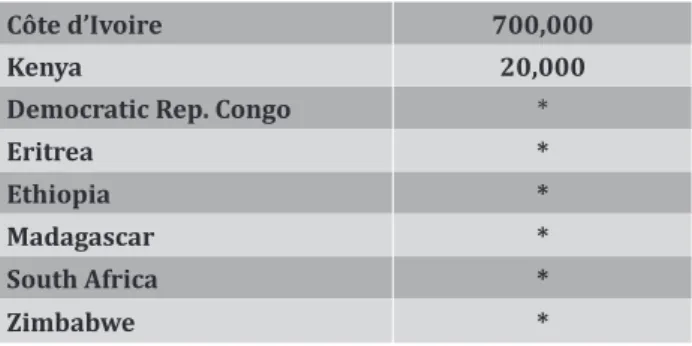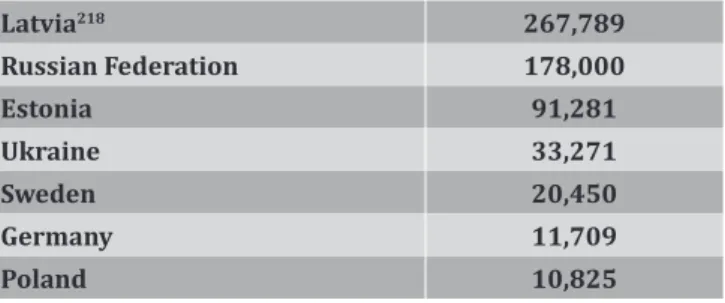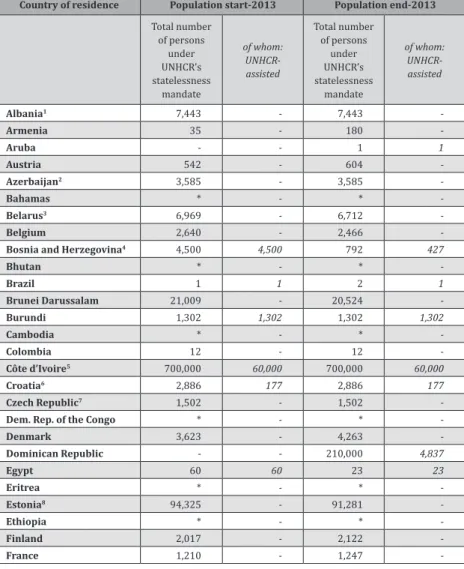The Institute for Statelessness and Inclusion is a non-profit foundation (Stichting) incorporated in the Netherlands. Currently, UNHCR is the only organization that systematically collects statistics and regularly reports on the number of stateless persons in the world.
INTRODUCTION
In this text, we identify some of the methodological challenges associated with the existing quantification of statelessness. The purpose of bringing this information together was to provide a snapshot of our collective understanding of the statistical scope of statelessness in today's world.
THE PROBLEM OF STATELESSNESS
- STATELESSNESS UNDER INTERNATIONAL LAW
- CAUSES OF STATELESSNESS
- IMPACT OF STATELESSNESS
- LINKS BETWEEN STATELESSNESS AND OTHER INTERNATIONAL CONCERNS
A person can be stateless in the country where he or she was born, has always lived and has all family ties. 18 See sections 3.VI and 3.VII on statelessness statistics in the Middle East and North Africa and on stateless refugees.
THE CHALLENGE OF MAPPING STATELESSNESS
METHODOLOGICAL ISSUES IN QUANTIFYING STATELESSNESS
Protection considerations in the identification of statelessness As explained, the categorization of persons as stateless or not is not always a straightforward exercise. 59 Note that the process of determining statelessness status in the context of migration can also lead to the establishment of nationality – i.e.
HIDDEN’ STATELESS GROUPS
- Not all countries in the world are able to report data on statelessness
- Figures for different countries are compiled from different data sets – that use different methodologies – and do not
- Countries where there is known to be a significant problem of statelessness, but no reliable figure, are indicated with an
- Only persons exclusively under UNHCR’s statelessness
66 According to the notes in the UNHCR statistical table, several figures included in Global Trends 2013 were actually taken from the 2009 (Azerbaijan), 2010 (Russian Federation and Tajikistan) or 2011 (several countries, including Croatia, the Czech Republic and Poland ). In the latter table - the only one included in the body.
Rohingya refugees, asylum seekers and people in refugee status included in UNHCR refugee statistics – this includes the 31,145 registered refugees and 200,000 of the estimated unregistered Rohingya population in Bangladesh, 40,660 registered in Malaysia and smaller numbers in other countries. Much of the decline in numbers is the result of forced displacement as a result of the conflict.
GLOBAL STATELESSNESS STATISTICS
GENERAL TRENDS
A figure or estimate for the total number of stateless persons worldwide – over 10 million – tells us only a small part of the story about this phenomenon. Thus, 97.6% of the number of stateless persons reported in UNHCR statistics at the global level can be found in just 20 countries. In terms of absolute numbers, the majority of persons UNHCR reports as falling under the statelessness mandate can be found in Asia and the Pacific.
Asia and the Pacific also stand out in terms of the number of severely affected countries. Thus, even if statelessness affected a large proportion of noncitizens, it would not add a significant number to the total number of stateless persons in America.

AFRICA
The explanatory note on Ivory Coast in the statistical table in which UNHCR reports a stateless population of 700,000 persons gives a good indication of the context in which statelessness arises in the country. Since 2005, UNHCR statistics have marked the country as one where statelessness is a problem (although the problem is much older), but a mapping of the situation in the country has not been possible due to the decades of civil conflict and the political sensitivity of the issue. Banyarwanda population is not known but is probably in the hundreds of thousands, possibly well over a million.
Makombo, “Civil conflict in the Great Lakes region: The issue of nationality of the Banyarwanda in the Democratic Republic of Congo,” in A. The combination of gender-discriminatory legislation and historical ethno-religious discrimination has perpetuated statelessness in the country.
AMERICAS
This expanded definition of the "in transit" exception was then enshrined in the new Dominican Constitution adopted in 2010. However, the figure captures only the first generation of persons of Haitian descent born in the Dominican Republic. The country generally follows the jus sanguinis principle, setting it apart from most other countries in the region.
Miller, “New Perspectives on Old Patterns: Forced Migration of Haitians in the Dominican Republic” in Journal of Ethnic and Migration Studies, Vol. 134 College of the Bahamas and International Organization on Migration, Haitian Migrants in the Bahamas, 2005, in particular Appendix 2.
ASIA AND THE PACIFIC
They are predominantly found in the northern part of the country and are estimated to number between 20,000 and 30,000 people. As with most other successor states of the Soviet Union, Kazakhstan is also affected by statelessness. 164 Human Rights Commission under the President of the Republic of Kazakhstan, Special Report on the Situation of the Rights of Oralman, Stateless Persons and Refugees in the Republic of Kazakhstan, 2012.
As such, it does not take into account any cases of statelessness in other parts of the country and is likely to under-represent the problem. In other countries that UNHCR has marked with an asterisk in its statelessness statistics, it is very difficult to find data on who is stateless and what the size of the population is.
EUROPE
224 This is indicated by a footnote in the statistical table of the UNHCR 2013 Global Trends report in which the data can be found. As is the case with Italy, UNHCR reports only a relatively small presence of stateless persons in the Netherlands - the figure in the 2013 General Trends is 1,951 persons. Again, similar to Germany, a further point of interest regarding statelessness in the Netherlands is the significant proportion of stateless persons born in the country.
See for an explanation of the difficulties of registering statelessness and the procedural reasons behind the large number of persons of unknown nationality in the Netherlands, K. 243 This is indicated by a footnote in the statistical table of the UNHCR report, Global Trends 2013, in which data can be found.
MIDDLE EAST AND NORTH AFRICA
254 12 out of the 27 countries whose nationality laws discriminate against women are in MENA. While it is widely known that the state hosts a large population of stateless Palestinians, 261 other cases of statelessness in the country receive far less attention. The number of stateless persons in the UAE is disputed and the UNHCR currently marks the country with a star in its statistical reporting.
Finally, there are further situations of statelessness in the MENA region that remain almost completely unreported by states and other actors. The foregoing demonstrates that statelessness is a very real problem in the Middle East and North Africa, outside of the specific context of the Palestinian community.
STATELESS REFUGEES
Note that media estimates of the number of Rohingya in the country range from 200,000 to 500,000 people. It is likely that all 9,378 refugees from West Papua326 reported by UNHCR to be in PNG are stateless.327. 324 For a summary of the Spanish judicial proceedings concerning the status of Sahrawi nationality, see, V.
Similarly, statelessness is a known issue in the Democratic Republic of the Congo and thus may also affect a number of over 450,000 refugees from the DRC. While there are still many gaps in the data on stateless refugees, the above gives a good impression of the intersection between statelessness and forced displacement.
STATELESS PALESTINIANS
275,000 Palestinian refugees in Saudi Arabia and another 140,000 in other Gulf countries.349 A significant number of Palestinian refugees also seek asylum or international protection further afield. Previous statistics, from 1980, showed a larger population of Palestinian refugees in Kuwait than the rest of the Gulf – almost 300,000 – but these figures are likely to have fallen since then as many Palestinians left Kuwait early of the 1990s due to a pending change. the conditions. There remain significant gaps in data on the total number of Palestinian refugees in different parts of the world.
Estimates put the number of these non-refugee Palestinians in Gaza at 400,000 and in the West Bank (including East Jerusalem) at 1.7 million. There are many Palestinians who have moved to live elsewhere in the region or other parts of the world, for example to work or study, who are likely to remain stateless and fall under UNHCR's statelessness protection mandate as non-refugees.

CONCLUSION &
RECOMMENDATIONS
Several other countries with significant populations at risk of statelessness are not even marked with an asterisk. On the other hand, this deeper and broader exploration of statelessness statistics has been unsatisfying because there are so many gaps in the data. Undocumented persons and persons of undetermined nationality may be at risk of becoming stateless and some of them are likely to be stateless already.
356 Note that the process of determining statelessness in the context of migration can also lead to the determination of citizenship – ie. They are duty bearers under international law who have obligations (both under international treaties on statelessness and under international human rights law) regarding the treatment of stateless persons and the avoidance of statelessness.
BIBLIOGRAPHY
Commission for Human Rights under the President of the Republic of Kazakhstan, Special Report on the Situation Regarding the Rights of Oralmen, Stateless Persons and Refugees in the Republic of Kazakhstan, 2012. Allerton, "Statelessness and the Lives of the Children of Migrants in Sabah, East Malaysia”, Tilburg Law Review, Volume 19, Issue 1-2, 2014 C. Kenya National Commission for Human Rights and UNHCR, Out of the Shadows: Towards Ensuring the Rights of Stateless Persons and Persons at Risk of Statelessness in Kenya, 2010.
UNHCR, Submission by the United Nations High Commissioner for Refugees to the Office of the High Commissioner for Human Rights. Synthesis Report - Universal Periodic Review: Pakistan, April 2012 UNHCR, Submission by the United Nations High Commissioner for Refugees for the Office of the High Commissioner for Human Rights.
ANNEX
3 Number of stateless persons registered by the Ministry of Citizenship and Migration of the Ministry of Internal Affairs of Belarus. 24 Figure from the 2010 census, which probably includes about 25,000 stateless persons registered by the Federal Migration Service of the Russian Federation. 28 The figure is an estimate and takes into account the number of stateless persons believed to have left the Syrian Arab Republic.
29 The figure is from the 2010 census, likely to include 308 people registered as stateless by the Ministry of Internal Affairs of Tajikistan. It includes 3,217 people who have been registered as stateless by the Ministry of Internal Affairs of Ukraine.
The World’s Stateless





